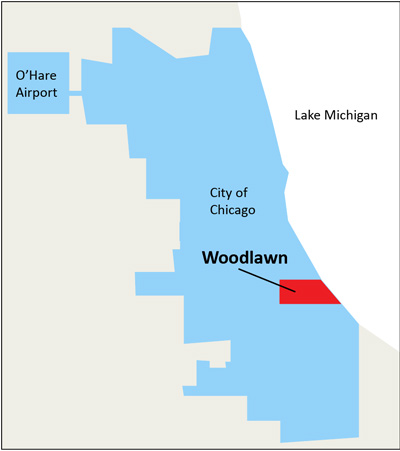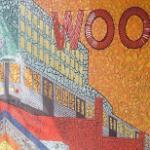Living in Woodlawn
 Wheaton in Chicago students live in two-bedroom apartments in the residential neighborhood of Woodlawn.
Wheaton in Chicago students live in two-bedroom apartments in the residential neighborhood of Woodlawn.
History of Woodlawn
Woodlawn is located on the traditional homelands of the Anishinaabe, or Council of the Three Fires: the Ojibwe, Odawa and Potawatomi Nations, as well as other Nations, including the Myaamia, Ho-Chunk, Menominee, Sac and Fox, Peoria, Kaskaskia, Wea Kickapoo, and Mascouten. After the 1833 Treaty of Chicago, the United States annexed Chicago and other areas into its territory. The neighborhood of Woodlawn – located about seven miles south of Chicago’s downtown and originally settled by Dutch farmers – began to grow in anticipation of the 1893 World’s Columbian Exposition. In the 1950s and 60s, Woodlawn shifted from a predominantly white to a majority black neighborhood, as a result of the Great Migration and expansion from the “Black Belt” or Bronzeville farther south, as well as white migration outward to the newly-developed suburbs with highway expansion and FHA-subsidized mortgages after World War II. Woodlawn’s 63rd Street corridor was a bustling commercial district with retail, restaurants, and jazz clubs. Despite or perhaps because of contending with racially-restrictive covenants, redlining, and other forms of economic disinvestment, Woodlawn has become a hub of the arts, activism, and community life – including influential figures such as playwright Lorraine Hansberry, Emmett and Mamie Till, poet laureate Gwendolyn Brooks, and artist Theaster Gates.
What’s Nearby
- Students have easy access to public transit through the CTA green and red lines, as well as buses, which connect Woodlawn to the rest of Chicago.
- Woodlawn includes hundreds of acres of beautiful green spaces, such as Washington Park, the Midway Plaisance, and Jackson Park, which includes the 63rd Street Beach and connects to the 18-mile Lakefront Trail. Other notable sites include the Museum of Science and Industry, University of Chicago, and the Obama Presidential Center, as well as restaurants, coffee shops, libraries and bookstores, community gardens, historic sites, and more.
/prod02/channel_1/media/anthropology/wheaton-in-chicago/Woodlawn_Mosaic.jpg)
/prod02/channel_1/media/anthropology/wheaton-in-chicago/Woodlawn._61st_Street_at_Sunset._Photo_Credit_Hannah_Helinsky.jpg)
/prod02/channel_1/media/anthropology/wheaton-in-chicago/Washington_Park_in_Fall.jpg)
 Start your application on GoGlobal, Wheaton’s registration system for off-campus study. The final deadline to apply is the end of the A-quad prior to the semester you wish to attend.
Start your application on GoGlobal, Wheaton’s registration system for off-campus study. The final deadline to apply is the end of the A-quad prior to the semester you wish to attend.